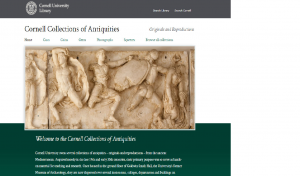New Arts & Sciences Grants Announced
We were delighted to receive twelve strong proposals for the seventh year of the Visual Resources Grants Program and are pleased to support three exciting projects, including one from a graduate student. Through these initiatives, we aim to expand our digital collections for research and teaching and contribute to the burgeoning field of scholarship in the digital humanities through the integration of new research methods, innovative data visualization, and tools that enable novel ways of analysis and interpretation.
19th Century Prison Reform Collection
PI: Katherine Thorsteinson, PhD candidate, English
In the early to mid-19th century, U.S. criminal justice was undergoing massive reform. The state prisons that had emerged out of earlier reform efforts were becoming increasingly crowded, diseased, and dangerous. This collection draws together invaluable documents surrounding the emergence and development of the Auburn and Pennsylvania Systems. These documents help chart the debate between these alternate prison reformation systems, the emergence of prison labor, the theological origins of the American prison, and the historical implications between slavery and mass incarceration. The collection supports research and teaching for a wide variety of disciplines, and is especially significant given the intensity with which the public is now concerned with the current state of incarceration.
NYS Historical Dendrochronology Project
PI: Carol Griggs, Classics, Tree-Ring Laboratory
Collaborators: Sturt Manning, Classics, Archaeology, Tree-Ring Laboratory; Brita Lorentzen, Tree-Ring Laboratory; Cynthia Kocik, Tree-Ring Laboratory
The New York State Historical Dendrochronology Project collects and uses dendrochronology to date wood samples from structures across upstate New York to provide precise dates of their construction, modification, and building history. The collection is comprised of approximately 80 sites and 1000 samples ranging from 1448 to 2016. The digitization of the physical samples and associated materials will provide easy access to this collection and will be of value to those in dendrochronology, history, archaeology, environmental and earth sciences, as well as museums, historical societies, and individuals interested in the history of the region. The digital collection will be used for historical, ecological, and climatological research on local, regional, and larger spatial scales and on annual to multi-century time scales.
Seneca Haudenosaunee Archaeological Materials, circa 1688-1754
PI: Kurt Jordan, Anthropology
Collaborator: Dusti Bridges, MA candidate, Archaeology
The goal of this project is to digitize and introduce archaeologically-recovered materials from two late 17th and early 18th century Seneca (O-non-dowa-gah) Haudenosaunee (Six Nations Iroquois) sites located near Geneva, New York into an online platform that will be meaningful for descendant communities as well as researchers in Anthropology, History, and American Indian and Indigenous Studies. It will provide information on archaeological materials from a poorly-understood era to researchers, serve as a resource for education on the indigenous history of New York, and most importantly provide a means for descendant communities to access and explore their heritage.
The grants program aims to support collaborative and creative use of resources through the creation of digital content of enduring value to the Cornell community and scholarship at large. The program is funded by the College of Arts of Sciences and coordinated by Cornell University Library (CUL). The Arts & Sciences Visual Resources Advisory Group oversees the visual resources program and CUL’s Digital Consulting and Production Services (DCAPS) plans and implements the grant-funded projects. In addition to the grants program, the Arts and Sciences digitization program continues to support instructional needs by providing timely and convenient digitization services, especially for the History of Art and Visual Studies, Anthropology, Archaeology, History, Classics, and Music departments. By digitizing instructional materials and loading them into image databases, we provide campus-wide access to these resources in support of academic goals and allow their reuse and repurposing.
We are grateful for the contributions of Tre Berney, Jasmine Burns, Jenn Colt, Dianne Dietrich, Rhea Garen, Simon Ingall, and Melissa Wallace as they collaborated with faculty in preparing the proposals.

